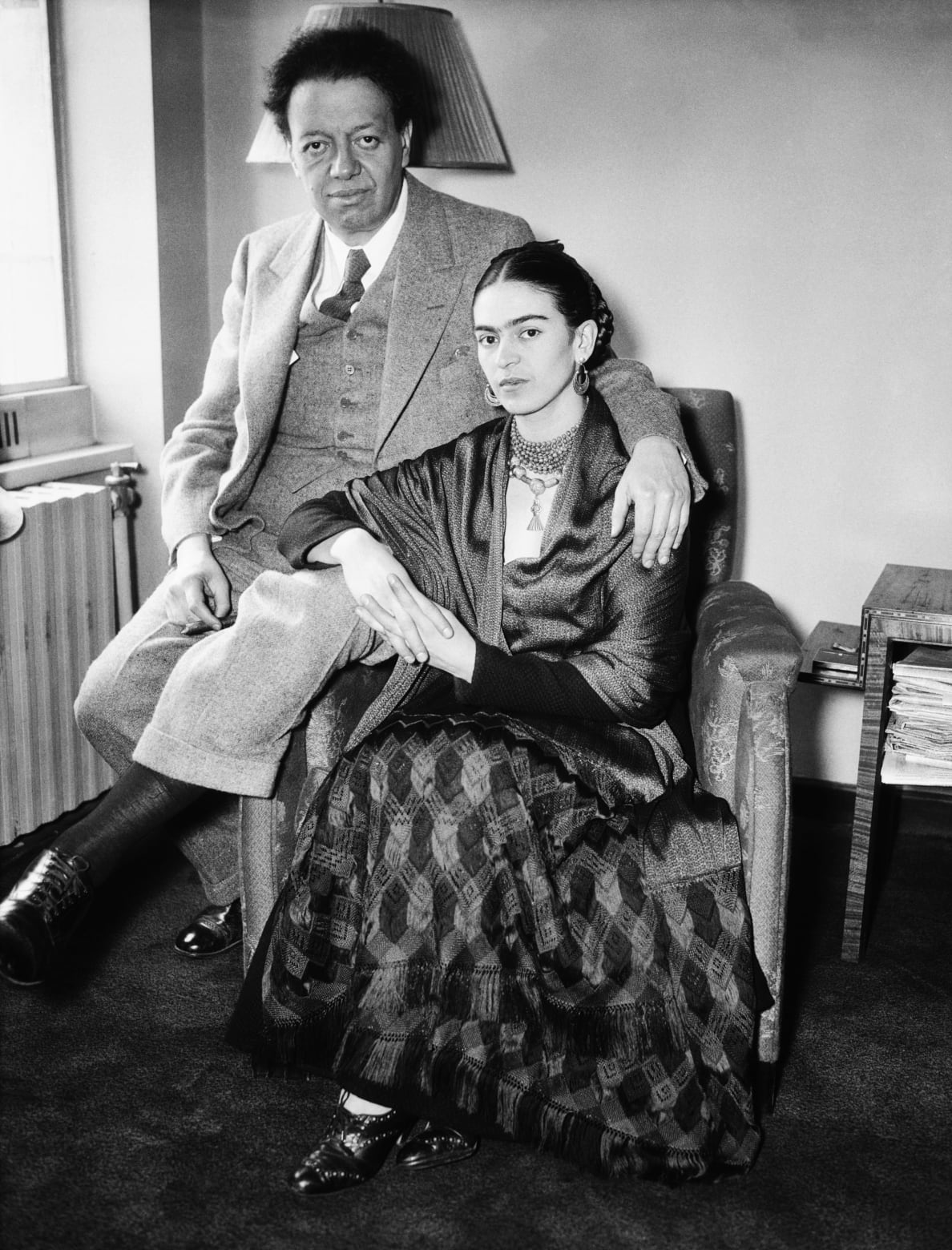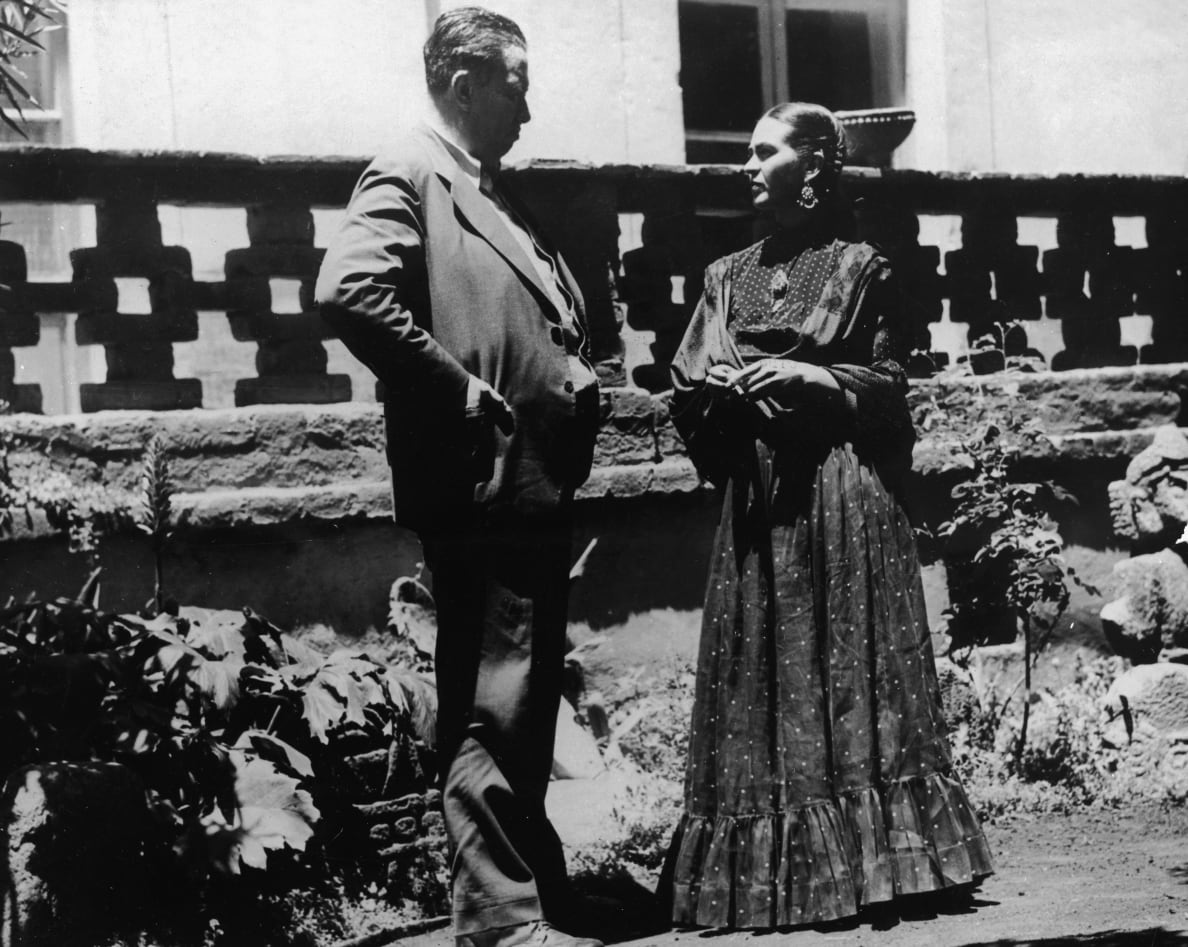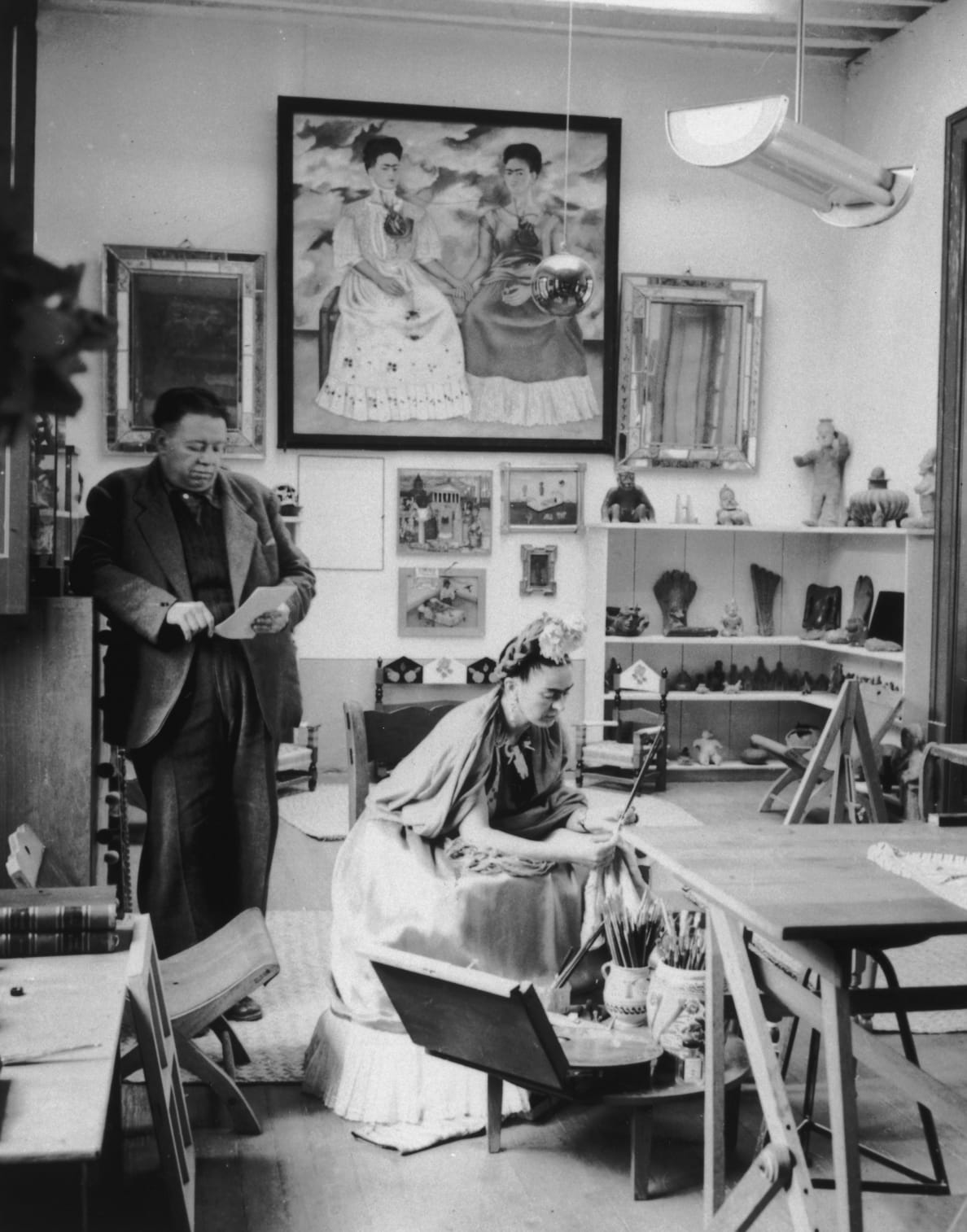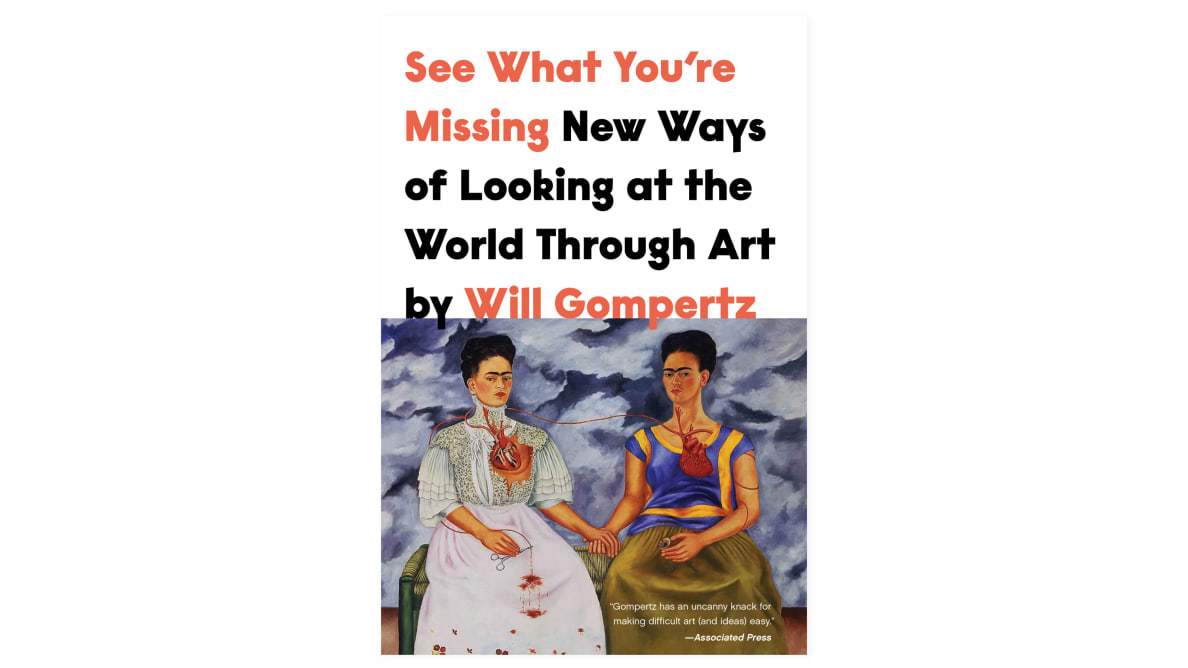Frida Kahlo’s story is well known. There’s the childhood polio. The elite female student at a predominantly male school. The bus crash at 18 that crushed her and her ambition to become a doctor. The monobrow. The early marriage to Diego Rivera, a fellow Mexican artist and revolutionary twenty years her senior. His affairs. Her affairs, including a brief fling with Leon Trotsky. Membership of the Mexican Communist Party. Her flirtation with Surrealism. Her death at 47. The 500 people who attended her funeral at the Palace of Fine Arts.
Frida Kahlo’s life was as colorful as her outfits. It’s been the subject of movies, of books, and of many, many exhibitions. But her biography is not why she is famous. There are countless individuals with vivid life stories who are now long forgotten. She has risen to the status of international icon because of her art, which has connected with people across time and space. Fans from the Americas, Europe and Asia politely wait in line to see her politically charged, allegorical images. They resonate universally, even though her paintings are neither technically brilliant nor staggeringly beautiful. They are more like poems in picture form, an artist baring her soul with brushstrokes rather than a pen.
Frida Kahlo had incredible vision. She knew it. When she was 19 she wrote a letter to her boyfriend Alejandro Gómez Arias about her uncanny ability to perceive what others could not. ‘I know everything now, without reading or writing… I know there is nothing else beyond; if there was, I would see it.’ She wasn’t boasting, more lamenting. The horrific accident that turned her from being a promising medic into a fledgling artist had happened only a few months earlier. She and Alejandro were traveling back to her hometown of Coyoacán on the outskirts of Mexico City when a tram crashed into the side of their bus, causing Frida to be impaled on a metal handrail. She survived, just, with a broken back, a smashed pelvis and several badly damaged organs. Her life thereafter was one of chronic discomfort and frequent operations. ‘Now I live on a painful planet,’ she wrote in the same letter, ‘transparent as ice; nothing is concealed.’
If there was any upside to that life-changing collision, it was the insight and time for observation with which it left her. In photographs subsequently taken by lovers as well as the dozens of self-portraits she produced throughout her adult life, you can see Frida seeing. The expressionless face, the red lips, the dark hair, the faint mustache – and those critical eyes. With Kahlo the lights were always switched on; even when wrecked through drink and drugs, she was measuring up the world as a tiger stalks a deer. There was an inscrutability to her countenance, a stillness to her presence: we don’t know what she is thinking but we definitively know that she is thinking.
It is too simplistic to say that the physical pain she endured was the subject of her highly personalized paintings. Such directness was never Frida Kahlo’s style. Symbolism, metaphor and story were the foundational elements of her art. The suffering she experienced because of her injuries was central to her art, but it wasn’t the only subject – it was more a way into a much broader range of concerns. She didn’t see pain, she used it to see.
To understand how she saw, it helps to consider how she might have thought. Frida Kahlo made the personal political long before the 1960s feminists claimed that notion as their own. She turned herself into the embodiment of her beloved Mexico, a nation in the process of creating a new identity following the end of colonial rule and the country’s subsequent decade-long revolution (1910–20). Her agenda was the people’s agenda, the agenda of the Mexican revolutionaries and their leaders, Emiliano Zapata and Pancho Villa. When she presented herself wounded but resolute in a painting, she was representing the spirit of a newly liberated Mexico as wounded but resolute. When her skin was pierced by a necklace of thorns, causing her to bleed, she was reflecting on the revolutionaries’ blood spilt during their struggles to save the country’s soul. When she split an image into two opposing halves, she was thinking of a divided Mexico. What she said, painted, wore and wrote was a statement about Mexico’s independence and culture. That was her subject. Pain was the lens through which she saw it.
The constant discomfort she felt gave her access to the extra-sensory faculties needed to reveal the daily agonies and ecstasies taking place within her cherished country. You can’t paint hurt without hurting. Frida Kahlo without pain is the Rolling Stones without Mick Jagger or a Margarita without tequila. The wounds and wonders she described in paint made plain her feelings, her heart pounding with joy one minute and broken in despair the next. She was a passionate woman who had many lovers, but none came close to Diego Rivera, who made her the happiest and saddest person to be alive. She once said, ‘I suffered two grave accidents in my life. One in which a streetcar knocked me down . . . the other is Diego.’
Rivera was already a world-famous, well-established, mid-career artist and revolutionary when he came to paint a mural in the amphitheater at the school the then fifteen-year-old Frida attended. He arrived with his paints and a gun in his pocket just in case any right-wing students attempted to kill him! As soon as she saw him enter her school, Frida knew they would become lovers and she would have his babies, a prediction made impossible to realize by the injuries she would suffer three years later. But he did become her one and only husband, by which time she was his third wife of what would be four. When they married, he was forty-three, she was twenty-two. He was big and stout, she was small and thin. They became a Mexican power couple, fêted in New York and Paris and admired at home. They entertained leading artists, politicians and members of the world’s intelligentsia. Theirs was a romanticized view of Mexico and, to an extent, of themselves. They described their artistic-political movement as Mexicanidad, proclaiming Mexico as a modern Marxist state free of foreign rulers and reconnected to its ancient Meso-american cultures of the Olmecs, the Maya and the Aztecs.

Diego Rivera and Frida Kahlo on December 8, 1939.
Bettmann/Getty Images
They promoted their causes through art and action, including membership of the Mexican Communist Party and a public rejection of religion. Diego made Modernist frescos celebrating a new world order of workers’ empowerment under enlightened communist leadership. Frida painted Stalin as a hero. Rivera collected ancient Mexican objects with his friend Miguel Covarrubias, which he would reference in his murals. Kahlo turned personal style into political activism by wearing the traditional clothes of Tehuana women, the indigenous descendants of the pre-Colombian Zapotec culture based around the Isthmus of Tehuantepec in southern Mexico. It was a feminist as well as a nationalist statement, a light shone on to a community in which women expressed their economic and social status through beautifully crafted dresses, skirts and blouses.
To the ancient, Kahlo and Rivera fused the avant-garde. The Mexican modernist architect Juan O’Gorman designed them a Le Corbusier-inspired his-and-hers art studio, interconnected by a concrete bridge at roof level and surrounded by a cactus fence. Diego was particularly pleased when he returned from America to see what his old friend had built. Separate studios with separate entrances were a perfect working environment for a womanizing artist. Frida largely put up with her husband’s bad temper and frequent infidelity, often giving as good as she got. But there was one affair she could not tolerate.
In 1934, five years after their marriage, Diego took Frida’s younger sister Cristina as his lover. Frida was devastated. ‘It is a twofold grief,’ she wrote to friends. ‘I only had Diego and my family at home.’ She went to New York to meet friends, and talked to her father – Wilhelm ‘Guillermo’ Kahlo – a German photographer who had moved to Mexico in the 1890s where he met and married her Mexican mother, Matilde. Frida adored her papa, who was instrumental in teaching her to see and be seen (he photographed her a lot), but he was no good when it came to the affair, as she noted: ‘My father is a wonderful person, but he reads Schopenhauer day and night, and is no help to me at all.’ He could cope with complex philosophy but not his daughter’s complex relationship. He disappeared into a book and said nothing.

Diego Rivera and Frida Kahlotalk together in the garden, near the porch of Kahlo's home in Mexico City, Mexico in 1937.
FPG/Getty Images
Frida’s work became fiercer and franker. The humor she once sneaked into her pieces evaporated. Satire evolved into a Freudian examination of selfhood: ‘Since my subjects have always been my sensations, my states of mind and the profound reactions that life has prompted in me, I have often objectified all this in figures of myself, which were the most real, most sincere thing I could do to express what I felt within and outside myself.’
When André Breton, the self-styled founder and leader of Surrealism, visited Mexico and saw her work he immediately claimed it – and her – to be part of his movement. He adored its darkness and anger, describing her delicate paintings of nightmares and abortions as being ‘a ribbon around a bomb’. He invited her to show her work in Paris, an offer she accepted – apart from anything else, she needed to get away from home. While she worked on a series of new paintings for the show in France – and presented a successful exhibition in New York – her marriage was disintegrating. Her sister was still part of Diego’s romantic life four years after the affair had started, and Frida was not putting up with it any longer. In 1939 she divorced Diego, which led to her producing one of her most famous pictures, Las Dos Fridas (The Two Fridas), which now hangs in the Museo de Arte Moderno in Mexico City.
It is much, much bigger than her usual paintings, which tended to be quite small as she was frequently bed-bound, or sitting with restricted mobility. Las Dos Fridas, though, is a large square composition measuring 173.5cm x 173cm – not far off life-size. There are two explanations for this sudden upscaling. One is commercial. André Breton advised her to make some larger works for her Paris show, as European collectors preferred more sizeable paintings. And second, she had a lot to say. Las Dos Fridas is the ultimate break-up picture.
The tone is set by the background, which is stormy and ominous. In the foreground, sitting on a green wicker bench, are the two Fridas. They are holding hands, united. Their shoulders are turned slightly towards one another, but their eyes stare directly out to the viewer: this is no interior conversation piece, they are talking to us. One Frida is wearing traditional Mexican clothes, the other a colonial-style wedding dress. These are the two sides to Frida: Mexican Frida with indigenous Indian roots on her mother’s side, and European Frida with her father’s German heritage on the other. We suspect Diego prefers Mexican Frida because it is this Frida who is holding a miniature picture of him in her left hand. It is attached to a vein full of blood that winds itself up her arm and into her halved heart, which is exposed outside her body. The vein exits from an artery and makes its way over to European Frida, who has the other half of the heart beating over her breast. The vein passes through another artery and makes its way down to her right hand, which holds a pair of scissor forceps, clamped over the vein to stop it bleeding. Well, not entirely. A little blood has dripped on to European Frida’s dress, blending in with the red flower decoration on its rim.
You can see why Breton, with his taste for the macabre and disturbed, would have delighted in Frida’s ghoulish account of her marriage. She’s laid it all out there in the open: the organ failures, the hospitalizations, the anatomical knowledge from studying medicine, the dualistic nature of her background (a mestizo, meaning mixed race), her stoicism, the older and younger self, the interior and exterior, the mind and body, Madonna and child, life and death.

Circa 1945, married Mexican artists Diego Rivera and Frida Kahlo read and work in a studio. Kahlo's self-portrait, 'The Two Fridas' (1939), hangs in the background with other works.
Hulton Archive/Getty Images
European Frida has blood on her hands, Mexican Frida has love in hers. The menacing sky closes in, a sign of anxiety over a future direction – Western subjugation or Mexican values? There’s more. Although she was a publicly stated atheist, religion played a significant role in her painting style and outlook. It is there in the depiction of the sacred heart, bleeding and damaged, with the ventricles rising to form a cross in the hope, perhaps, of a miracle cure. The blood could be the blood of Christ, a symbol of martyrdom, unconditional love and redemption. The painting of Diego is a retablo, a small devotional picture that is part of the folk art of the Catholic Church, into which Kahlo was born. Has she refound her faith in God rather than in an unfaithful man? Her walls were covered in ex-votos, postcard-sized pictures that offer a prayer in the form of a pictorial story accompanied by text. They were a notable influence on Frida, whose paintings owe a lot to the ex-voto aesthetic, particularly the way they favored an easily legible image over painterly technique. There’s no attempt to convincingly represent perspective, or to achieve even basic levels of academic draftsmanship. Unnecessary flourishes are put aside to give prominence to the story encapsulated in the image. The result is a rigid, stiff composition that gives ex-voto images a distinctly spooky look: an effect Kahlo comprehensively mastered.
Las Dos Fridas didn’t sell when exhibited, unlike many of her other pictures. Maybe Breton was wrong to encourage Frida to go large. He was certainly wrong about her being a Surrealist, as she made clear with this statement: ‘I never painted my dreams, I painted my own reality.’ That is the way into her art. Her pictures were not the whimsical meanderings Breton believed them to be. They belonged to the time and place in which Kahlo lived. She made images that were overtly political, often with more than a hint of propaganda. She was deeply committed to helping shape the future of Mexico, and did so by becoming its cultural embodiment. The artist and her nation were inseparable, and still are today.
Frida Kahlo would probably have been a doctor if it wasn’t for the bus accident. Instead of breaking her, it was the making of her. She learnt to live with the pain and to use it as a way of seeing the world and her place in it, the pain of the crash, of the miscarriages, of Diego’s affairs, of her sister’s betrayal, of a colonial past, of lost traditions, of an overbearing West, of her country’s turmoil. She was a force of nature whom few could resist. Not even Diego, who asked her to remarry him a year after their divorce. Which she did.

"behind" - Google News
April 09, 2023 at 02:14PM
https://ift.tt/1yGBXOA
The Story Behind the Greatest Break-Up Painting of All Time - The Daily Beast
"behind" - Google News
https://ift.tt/yRML47V
https://ift.tt/qob3eQF
Bagikan Berita Ini














0 Response to "The Story Behind the Greatest Break-Up Painting of All Time - The Daily Beast"
Post a Comment